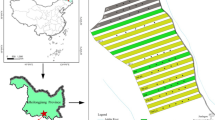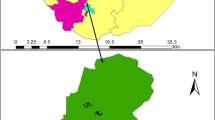Abstract
The tree species diversity, groundvegetation species richness, and soilcharacteristics were studied forEucalyptus camaldulensis woodlots and thenatural miombo woodlands in the Mukarakate Areaof Northeastern Zimbabwe. The woodlandcharacteristics were measured and soil sampleswere taken at a total of thirty-four miombowoodland plots and twenty-seven eucalyptusplantations.
The number of tree species was significantlyhigher for the miombo woodland sites than forthe eucalyptus woodlots. The Berger-Parker andShannon-Wiener Index values for speciesdiversity were higher for the tree speciesfound on the miombo woodland sites. There wereno significant differences between theeucalyptus woodlots and the miombo woodlands inthe percentage of grass cover and the number ofgrass and herb species. The same grass and herbspecies were common in both the woodlots andthe woodlands. The older woodlots hadsignificantly more tree and herb species thanthe younger woodlots.
Soil nutrient analyses showed no significantdifferences between the woodlots and thewoodlands regarding their available phosphorusand total nitrogen, but the total phosphorusand total carbon were higher for the miombowoodlands. The results suggest that E.camaldulensis woodlots established in areasthat were formerly fields and grazing areas inthe savannah-like conditions pertaining inSouthern Africa do not cause the loss ofspecies richness or soil nutrients. In heavilydeforested areas eucalyptus woodlots may evencontribute positively to the protection andpreservation of indigenous trees species andother flora.
Similar content being viewed by others
References
ACIAR 1992. Eucalyptus: Curse or Cure? Australian Centre for International Agricultural Research, Canberra. Statement. 6 p.
Bargali, S.S., Singh, R.P. and Joshi, M. 1993. Changes in soil characteristics in eucalypt plantations replacing natural broad-leaved forests. Journal of Vegetation Science 4: 25-28.
Bone, R., Lawrence, M. and Magombo, Z. 1997. The effect of a Eucalyptus camaldulensis (Dehn) plantation on native woodland recovery on Ulumba Mountain, southern Malawi. Forest Ecology and Management 99: 83-99.
Bowen, G.D. and Nambiar, E.K.S. (Eds) 1984. Nutrition of Plantation Forests. Academic Press Inc. London. 516 p.
Brinn, P.J. 1987. Communal Land Physical Resource Inventory. Murewa District, Report No. A54. Chemistry and Soil Research Institute. Harare, Zimbabwe. 44 p.
da Silva Junior, M.C., Scarano, F.R. and de Souza Cardel 1995. Regeneration of an Atlantic forest formation in the understorey of a Eucalyptus grandis plantation in south-eastern Brazil. Journal of Vegetation Science 11: 147-152.
Evans, J. 1992. Plantation Forestry in the Tropics. Clarendon Press, Oxford, USA. 403 p.
Geldenhuys, C.J. 1997. Native forest regeneration in pine and eucalypt plantations in Northern Province, South Africa. Forest Ecology and Management 99: 101-115.
Green, T. 1991. The controversy of planting Eucalypts in Lesotho, pp. 1038-1043. In: Symposium on Intensive Forestry: The Role of Eucalyptus. International Union of Forestry Research Organizations, Durban, South Africa.
Harrington, R.A. and Ewel, J.E. 1997. Invasibility of tree plantations by native and nonindigenous plant pecies in Hawaii. Forest Ecology and Management 99: 153-162.
Hillis, W.E. and Brown, A.G. 1984. Eucalypts for Wood Production. Commonwealth Scientific and Industrial Research Organization, Australia. 434 p.
Jackson, M.L. 1958. Soil Chemical Analysis. Prentice Hall, Inc. Englewood Clifs, USA.
Jha, M.N. and Pande, P. 1984. Impact on growing Eucalyptus and sal monocultures on soil in natural sal area of Doon Valley. Indian Forester 110: 16-22.
Jocque, C.A. Malawi. A Terrestrial Baselines Study of the Viphya Pulpmill Project Area. FAO Internal Report.
Kumar, V. 1991. Eucalyptus in the forestry scene of India, pp. 1105-1116. In: Symposium on Intensive Forestry: The Role of Eucalyptus. International Union of Forestry Research Organizations, Durban, South Africa.
Kwembeya, E.G. and Takawira, R. 1997. A Checklist of Zimbabwean Vernacular Plant Names. DR&SS. Harare.
Loumeto, J.J. and Huttel, C. 1997. Understory vegetation in fast growing tree plantations on savanna soils in Congo. Forest Ecology and Management 99: 65-81.
Mandondo, A. 1993. Management and Growth and Survival of Eucalyptus Camaldulensis in Murewa and Mutoko Districts of Zimbabwe. M.Sc. Thesis, University of Zimbabwe. 118 p.
Mandondo, A. and Jackson, J. 1996. Management and Performance of Eucalyptus Camaldulensis in Murewa and Mutoko Districts of Zimbabwe. Working Paper of Institute of Environmental Studies, University of Zimbabwe. 8 p.
Mathur, H.N., Jain, N. and Sajwan, S.S. 1980. Ground cover and undergrowth in Eucalyptus, brushwood and sal forest - an ecological assessment. Van Vigyan 18: 56-61.
Mathur, H.N. and Soni, P. Comparative account on undergrowth under Eucalyptus and Sal in three different localities of Doon Valley. Indian Forester 109: 882-890.
Mukamuri, B. 1995. Making Sense of Social Forestry. A Political and Contextual Study of Forestry Practices in South Central Zimbabwe. Acta Universitatis Tamperensis serie A volume 438. 212 p.
Page, A.L. (Ed) 1982. Methods of Soil Analysis, Part 2. Agronomy Series 9. Madison, USA.
Parrotta, J.A. 1995. Influence of overstory composition on understory colonization by native species in plantations on a degraded tropical site. Journal of Vegetation Science 6: 627-636.
Parrotta, J.A., Turnbull, J.W. and Jones, N. 1997. Catalyzing native forest regeneration on degraded tropical lands. Forest Ecology and Management 99: 1-7.
Parrotta, J.A. 1999. Productivity, nutrient cycling, and succession in single-and mixed-species plantations of Casuarina equisetifolia, Eucalyptus robusta and Leucaena leucocephala in Puerto Rico. Forest Ecology and Management 124: 45-77.
Peach, K. and Tracey, M.V. 1956. Modearn Methods of Plant Analysis. Springer-Verlag, Berlin.
Poore, M.E.D. and Fries, C. 1985. The Ecological Effects of Eucalyptus. FAO Forestry Paper 59. 88 p.
Pukkala, T. 1996. Calculation of Forest Inventory Results. Forest Management and Conservation Programme, World Bank, Vientiane, Lao. 33 pp.
Rajvanshi, A., Soni, S., Kukreti, U.D. and Srivastava M.M. 1983. A comparative study of undergrowth of sal forest and eucalyptus plantation at Golatappar-Dehra Dun during rainy season. Indian Journal of Forestry 6: 117-119.
Ranta, E., Rita, H. and Kouki, J. 1992. Biometria. Tilastotiedettä ekologeille. Yliopistopaino, Helsinki. 569 p.
Remme, H., Campbell, B., Chikandiwa, F. and Nobane, N. 1997. tiAn Overview of Forestry Activities and Extension in the Communal Lands of Zimbabwe. Forestry Extension Services, Forestry Commission and Institute of Environmental Studies, University of Zimbabwe. 28 p.
Schönau, A.P.G. 1991. Role of eucalypt plantations in timber supply and forest conservation in sub-Saharan Africa. Southern African Forestry Journal 156: 56-60.
Stagman, G. 1978. An Outline of the Geology of Rhodesia. Whitsun Foundation, Salisbury, Rhodesia, pp. 29-81.
Timberlake, J.R., Nobanda, N. and Mapaure, I. 1993. Vegetation survey of the communal lands - North and East Zimbabwe. Kirkia 14: 171-270.
Tyynelä, T. and Niskanen, A. 2000a. Communal management and social benefits of woodland resources in Zimbawe, pp. 65-85. In: Virtanen, P. and Nummelin, M. (Eds) Forest, Chiefs and Peasants in Africa: Local Management of Natural Resources in Tanzania, Zimbabwe and Mozambique, Vol. 34. Silva Carelica.
Tyynelä, T. and Niskanen, A. 2000b. Use and sustainability of miombo woodlands under community management in Zimbabwe. Nordic Journal of African Studies 9(1): 118-143.
Van Wyk, B. and van Wyk, P. 1997. Field Guide to Trees of Southern Africa. Struik Publishers, Cape Town, South Africa.
Vuokila, Y. (Ed) 1987. Metsikkökokeiden maastotyöohjeet. Metsäntutkimuslaitoksen tiedonantoja 257. Helsinki, Finland. 237 p.
Whitlow, J.R. 1987. A national soil erosion survey for Zimbabwe. Journal of Soil and Water Conservation 42(4).
Yadav, J.S.P., Banerjee, S.P., Badola, K.C. and Singh, K. 1973. Changes in soil properties consequent upon growing Eucalyptus in a natural sal (Shorea robusta) area. Indian Journal of Agricultural Chemistry 6: 109-115.
Author information
Authors and Affiliations
Rights and permissions
About this article
Cite this article
Tyynelä, T.M. Species diversity in Eucalyptus camaldulensis woodlots and miombo woodland in Northeastern Zimbabwe. New Forests 22, 239–257 (2001). https://doi.org/10.1023/A:1015616010976
Issue Date:
DOI: https://doi.org/10.1023/A:1015616010976




